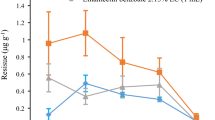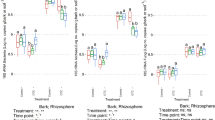Abstract
Fluopyram, an excellent nematicide, has better water solubility than abamectin; this feature is important for its systemic transport in trees as a trunk-injection agent. To identify the potential of fluopyram as a trunk-injection agent against Bursaphelenchus xylophilus, its toxicity to different developmental stages and effects on the egg hatching and reproduction of B. xylophilus were studied. Fluopyram exhibited significant nematicidal activity similar to that of abamectin, with LC50 values of 0.945, 1.69 and 3.23 mg L− 1 for second-stage juveniles (J2), third-stage juveniles (J3) and fourth-stage juveniles/adults (J4/adults), respectively. The hatching rate at a fluopyram concentration of 3 mg L− 1 was 20.78%, significantly lower than that in the control group (90.48%) at 24 h. In addition, the reproduction of B. xylophilus at a concentration of 2.21 mg L− 1 decreased significantly, similar to the effect of abamectin at 1.42 mg L− 1. In a hydroponic experiment, fluopyram treatment decreased the number of B. xylophilus at a concentration of 64 mg L− 1. Fluopyram exhibited a greater inhibitory effect than abamectin. Overall, fluopyram has significant nematicidal activity against B. xylophilus and shows potential to be a new trunk-injection agent.



Similar content being viewed by others
References
Aćimović, S. G., VanWoerkom, A. H., Reeb, P. D., Vandervoort, C., Garavaglia, T., Cregg, B. M., & Wise, J. C. (2014). Spatial and temporal distribution of trunk-injected imidacloprid in apple tree canopies. Pest management science, 70(11), 1751–1760.
Avenot, H. F., & Michailides, T. J. (2010). Progress in understanding molecular mechanisms and evolution of resistance to succinate dehydrogenase inhibiting (SDHI) fungicides in phytopathogenic fungi. Crop Protection, 29(7), 643–651.
Bi, Z., Gong, Y., Huang, X., Yu, H., Bai, L., & Hu, J. (2015). Efficacy of four nematicides against the reproduction and development of pinewood nematode, Bursaphelenchus xylophilus. Journal of nematology, 47(2), 126.
Bonifácio, L. F., Sousa, E., Naves, P., Inácio, M. L., Henriques, J., Mota, M., Barbosa, P., Drinkall, M. J., & Buckley, S. (2014). Efficacy of sulfuryl fluoride against the pinewood nematode, Bursaphelenchus xylophilus (Nematoda: Aphelenchidae), in Pinus pinaster boards. Pest management science, 70(1), 6–13.
Byrne, F. J., Urena, A. A., Robinson, L. J., Krieger, R. I., Doccola, J., & Morse, J. G. (2012). Evaluation of neonicotinoid, organophosphate and avermectin trunk injections for the management of avocado thrips in California avocado groves. Pest management science, 68(5), 811–817.
Byrne, F. J., Krieger, R. I., Doccola, J., & Morse, J. G. (2014). Seasonal timing of neonicotinoid and organophosphate trunk injections to optimize the management of avocado thrips in California avocado groves. Crop Protection, 57, 20–26.
Cabrera, J. A., Menjivar, R. D., Dababat, A. E. F. A., & Sikora, R. A. (2013). Properties and nematicide performance of avermectins. Journal of Phytopathology, 161(2), 65–69.
Cheng, L., Xu, S. Y., Xu, C. M., Lu, H. B., Zhang, Z. Q., Zhang, D. X., Mu, W., & Liu, F. (2017). Effects of trans-2‐hexenal on reproduction, growth and behaviour and efficacy against the pinewood nematode, Bursaphelenchus xylophilus. Pest management science, 73(5), 888–895.
Douda, O., Zouhar, M., Maňasová, M., Dlouhý, M., Lišková, J., & Ryšánek, P. (2015). Hydrogen cyanide for treating wood against pine wood nematode (Bursaphelenchus xylophilus): results of a model study. Journal of wood science, 61(2), 204–210.
Faske, T. R., & Hurd, K. (2015). Sensitivity of Meloidogyne incognita and Rotylenchulus reniformis to Fluopyram. Journal of nematology, 47(4), 316.
Fonseca, L., Cardoso, J., Lopes, A., Pestana, M., Abreu, F., Nunes, N., Mota, M., & Abrantes, I. (2012). The pinewood nematode, Bursaphelenchus xylophilus. Madeira Island. Helminthologia, 49(2), 96–103.
Huang, X. J. (2014). Chemical stress against the reproduction and mating behavior of Bursaphelenchus xylophilus. Zhejiang A & F University, Zhejiang, Hangzhou, China.
Kwon, H. R., Choi, G. J., Choi, Y. H., Jang, K. S., Sung, N. D., Kang, M. S., Moon, Y., Lee, S. K., & Kim, J. C. (2010). Suppression of pine wilt disease by an antibacterial agent, oxolinic acid. Pest Management Science, 66(6), 634–639.
Labourdette, G., Lachaise, H., Rieck, H., & Steiger, D. (2010). Fluopyram: a new antifungal agent for the control of problematic plant diseases of many crops. Julius-Kühn-Archiv, 428, 91–92.
Lee, K. S. (2014). Stability analysis and optimal control strategy for prevention of pine wilt disease. In Abstract and Applied Analysis (Vol. 2014). Hindawi. 1–15.
Lee, H. R., Lee, S. C., Lee, D. H., Choi, W. S., Jung, C. S., Jeon, J. H., Kim, J. E., & Park, I. K. (2017a). Identification of the aggregation-sex pheromone produced by male Monochamus saltuarius, a major insect vector of the pine wood nematode. Journal of chemical ecology, 43(7), 670–678.
Lee, B. H., Yang, J. O., Beckett, S., & Ren, Y. (2017b). Preliminary trials of the ethanedinitrile fumigation of logs for eradication of Bursaphelenchus xylophilus and its vector insect Monochamus alternatus. Pest management science, 73(7), 1446–1452.
Li, Q., Zhang, S. Y., Qiu, H. K., Chen, M., Ye, Y. Z., & Yuan, Y. (2016). Field efficacy of six trunk-injected pesticides on Bursaphelenchus xylophilus. Journal of Zhejiang A & F University, 33, 718–723.
Lu, H., Xu, S., Zhang, W., Xu, C., Li, B., Zhang, D., Mu, W., & Liu, F. (2017). Nematicidal activity of trans-2-hexenal against southern root-knot nematode (Meloidogyne incognita) on tomato plants. Journal of agricultural and food chemistry, 65(3), 544–550.
Mamiya, Y. (1988). History of pine wilt disease in Japan. Journal of nematology, 20(2), 219.
Mao, X., Li, H., & Chen, X. (2004). Extraction efficiency of soil nematodes by differnt methods. Chinese Journal of Ecology, 23(3), 149–151.
Matsuura, K. (1984). Control of the pine wilt disease caused by pinewood nematodes [Bursaphelenchus xylophilus] with trunk-injection. Shokubutsu boeki, 38, 27–31.
Mota, M. M., Braasch, H., Bravo, M. A., Penas, A. C., Burgermeister, W., Metge, K., & Bravo, M. A. (1999). First report of Bursaphelenchus xylophilus in Portugal and in Europe. Nematology, 1(7), 727–734.
Mota, M. M., & Vieira, P. (Eds.). (2008). Pine wilt disease: a worldwide threat to forest ecosystems (pp. 1–3). Heidelberg: Springer.
Navarro, C., Fernández-Escobar, R., & Benlloch, M. (1992). A low-pressure, trunk-injection method for introducing chemical formulations into olive trees. Journal of the American Society for Horticultural Science, 117(2), 357–360.
Oka, Y., & Saroya, Y. (2019). Effect of fluensulfone and fluopyram on the mobility and infection of second-stage juveniles of Meloidogyne incognita and M. javanica. Pest management science, 75(8), 2095–2106.
Pajares, J. A., Álvarez, G., Hall, D. R., Ibarra, N., Hoch, G., Halbig, P., Cocos, D., Johansson, H., & Schroeder, M. (2017). Attractants for management of the pine sawyer beetle Monochamus sutor, a potential vector of Bursaphelenchus xylophilus. Journal of Applied Entomology, 141(1–2), 97–111.
Percival, G. C., & Boyle, S. (2005). Evaluation of microcapsule trunk injections for the control of apple scab and powdery mildew. Annals of Applied Biology, 147(1), 119–127.
Qi, Z. Q., Wang, J. X., Chen, C. J., & Zhou, M. G. (2006). Efficacy of the methylene bisthiocyanate formulation, 4.2% MBT EC, as a potentially novel nematicide for the control of root-knot nematode. Australasian Plant Pathology, 35(6), 733–737.
Requena, A. M., Candela, M. E., Requena, M. E., & Egea-Gilabert, C. (2011). Host-pathogen interaction of root-knot nematode Meloidogyne incognita on pepper in the southeast of Spain. European journal of plant pathology, 131(3), 511.
Ryss, A. Y., Kulinich, O. A., & Sutherland, J. R. (2011). Pine wilt disease: a short review of worldwide research. Forestry Studies in China, 13(2), 132–138.
Sarniguet, C., Buisson, A., & Anthoine, G. (2013). Validation of morphological keys for identification of Bursaphelenchus xylophilus (Nematoda, Parasitaphelenchidae) to group and species level. EPPO Bulletin, 43(2), 255–261.
Schneider-Orelli, O. (1947). Entomologisches Praktikum. Aarau: HR Sauerlander.
Shen, Y. C., & Yang, H. X. (1994). Development and characteristics of avermectin, an insecticide antibiotic. World Pesticides, 3, 1–13.
Sousa, E., Naves, P., Bonifácio, L., Inácio, L., Henriques, J., & Evans, H. (2011). Survival of Bursaphelenchus xylophilus and Monochamus galloprovincialis in pine branches and wood packaging material. EPPO Bulletin, 41(2), 203–207.
Sousa, E., Naves, P., & Vieira, M. (2013). Prevention of pine wilt disease induced by Bursaphelenchus xylophilus and Monochamus galloprovincialis by trunk injection of emamectin benzoate. Phytoparasitica, 41(2), 143–148.
Takai, K., Soejima, T., Suzuki, T., & Kawazu, K. (2000). Emamectin benzoate as a candidate for a trunk-injection agent against the pine wood nematode, Bursaphelenchus xylophilus. Pest Management Science, 56(10), 937–941.
Takai, K., Soejima, T., Suzuki, T., & Kawazu, K. (2001). Development of a water-soluble preparation of emamectin benzoate and its preventative effect against the wilting of pot‐grown pine trees inoculated with the pine wood nematode, Bursaphelenchus xylophilus. Pest Management Science, 57(5), 463–466.
Takai, K., Suzuki, T., & Kawazu, K. (2004). Distribution and persistence of emamectin benzoate at efficacious concentrations in pine tissues after injection of a liquid formulation. Pest Management Science, 60(1), 42–48.
Tan, Q. Q., Wu, H. Y., Jiang, S. X., & Bing, H. (2013). Mortality and movement behaviour of Bursaphelenchus xylophilus under different dosages of copper sulphate. Plant Protection Science, 49(2), 98–103.
Tóth, Á (2011). Bursaphelenchus xylophilus, the pinewood nematode: its significance and a historical review. Acta Biologica Szegediensis, 55(2), 213–217.
Urek, G., Širca, S., & Geric, B. (2007). Morphometrical and molecular characterization of Bursaphelenchus species from Slovenia. Helminthologia, 44(2), 37–42.
VanWoerkom, A. H., Aćimović, S. G., Sundin, G. W., Cregg, B. M., Mota-Sanchez, D., Vandervoort, C., & Wise, J. C. (2014). Trunk injection: an alternative technique for pesticide delivery in apples. Crop Protection, 65, 173–185.
Vicente, C., Espada, M., Vieira, P., & Mota, M. (2012). Pine wilt disease: a threat to European forestry. European journal of plant pathology, 133(1), 89–99.
Vosberg, S. K., Marburger, D. A., Smith, D. L., & Conley, S. P. (2017). Planting date and fluopyram seed treatment effect on soybean sudden death syndrome and seed yield. Agronomy Journal, 109(6), 2570–2578.
Wang, M. Z. 1998. Studies on Plant Nematodes in China. Hubei Science Technology Press, 10–92.
Xu, F. (2008). Recent advances in the integrated management of the pine wood nematode in China. In Pine wilt disease (pp. 323–333). Tokyo: Springer.
Yang, Z. H., Tian, H., & Liu, Y. Y. (2017). Research development of new-type bactericide-fluopyram. Modern Chemical Research, 4, 103–104.
Zhao, B. G., Futai, K., Sutherland, J. R., & Takeuchi, Y. (2008). Pine Wilt Disease. Japan: Springer.
Zhao, L., Jiang, P., Humble, L. M., & Sun, J. (2009). Within-tree distribution and attractant sampling of propagative pinewood nematode, Bursaphelenchus xylophilus: An early diagnosis approach. Forest ecology and management, 258(9), 1932–1937.
Acknowledgements
The study was supported by the National Key R and D Program of China (2017YFD0600102). The authors thank Prof. Zhenyu Liu for providing the Botrytis cinerea and B. xylophilus cultures.
Author information
Authors and Affiliations
Corresponding author
Ethics declarations
Conflict of interest
The authors declare no conflict of interest.
Ethical approval
The research did not involve any animal and/or human trials.
Rights and permissions
About this article
Cite this article
Liu, G., Lin, X., Xu, S. et al. Efficacy of fluopyram as a candidate trunk-injection agent against Bursaphelenchus xylophilus. Eur J Plant Pathol 157, 403–411 (2020). https://doi.org/10.1007/s10658-020-02023-8
Received:
Revised:
Accepted:
Published:
Issue Date:
DOI: https://doi.org/10.1007/s10658-020-02023-8




